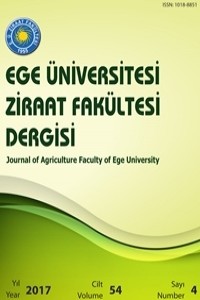Türkiye’de Manisa İli Salihli İlçesi Kapancı Köyü’nde Çekirdeksiz Kuru Üzüm Üretiminde Yerel İnovasyon Ağları
Abstract
Bu çalışmada Kapancı Köyü’nde (Salihli
İlçesi Manisa İli, Türkiye) çekirdeksiz kuru üzüm üretimindeki yerel bilgi ve
inovasyon ağları katılımcı yöntemler kullanılarak incelenmiştir. Çiftçiler,
yayım elemanları (kamu ve ziraat odası); girdi satıcıları, araştırmacılar tartışma
oturumlarına katılmışlardır. Piyasa fırsatları, gereksinimler, bitki koruma
çabaları, rekabet ve krizler öğrenmede ve yeniliklerin benimsenmesinde
yönlendiriciler olarak belirlenmiştir. Üretim maliyetlerindeki artış köyde
teknoloji (alet-ekipman, materyal vb.) benimsenme eğilimini artırmıştır.
Köydeki çiftçiler yüksek problem çözme becerilerine sahiptirler. Ağdaki en
önemli aktörler girdi satıcıları ve özel firmalar olarak görülmektedirler. Çiftçiler yerel bilgi ve uygulamaların
bugünkü tarım koşullarında yetersiz
kaldığını düşünmektedirler. Çiftçiler kendi önceliklerinin ve
koşullarının bölgedeki araştırma ve
yayım etkinliklerinde yeterince gündeme alındığına inanmamaktadırlar.
Çiftçilerin kamu yayım örgütleri ile bağlantıları genel olarak zayıftır.
Çiftçilere göre, kamu yayım önerileri genellikle teorik olup, ekonomik
geçerlilikleri sınırlıdır. Kuru üzüm üretimindeki yerel inovasyon ağları piyasa
yönlendirmeli ve çoğulcu fakat formal bilgi ve inovasyon sistemleri ile zayıf
bağlara sahip olarak tanımlanabilir.
References
- Anonymous, 2013, Kuru uzum sektor raporlari (sectoral reports: raisin) TC Ekonomi Bakanligi Ihracat Genel Mudurlugu Tarim Urunlari Daire Baskanligi, www://blog:ibp.gov.tr, accessed: 31.07.2013
- Boz, I. and Ozcatalbas, O. 2010, Determining information sources used by cropproducers: A case study of Gaziantep province inTurkey, African Journal of Agricultural Research Vol. 5(10), pp. 980-987, 18 May, Available online at http://www.academicjournals.org/AJAR.
- Csaki, C., 1999. Agricultural higher education in transforming Central and Eastern Europe, Agricultural Economics 21 Pp: 109-120.
- Falloon, K., 2011, Institutional reforms of AKS in New Zealand and International Networks in AKS, New Zealand Mission to the European Union, Ministry of Science and Innovation, 15 June.
- Hartwich, F. and Scheidegger, U., 2010, Fostering innovation networks the missing piece in rural development, Rural Development News 1/2010, Pp: 70-75.
- MFAL, 2013, Some Indicators on Ministry of Agriculture and Rural Affairs, http://www.tarim.gov.tr/arayuz/9/habergoster.asp?ID= 967, Accessed: 07.07.2013
- Munyua, C., Adams, P., Thomson, T., 2002., Designing effective linkages for sustainable agricultural extension information systems among developing countries in Sub-Saharan Africa, AIAEE 2002, Proceedings of the 18th Annual Conference Durban, South Africa, 301-307p.
- Perez., S.A., Klerkx, L., and Leeuwis, C., 2010, Innovation brokers and their roles in value chain-network innovation, ISDA 2010, Innovation and Sustainable Development in Agriculture and Food, 28 June-1 July, Montpellier France.
- SOLINSA, 2010, Learning and Innovation Networks for sustainable Agriculture: Conceptional Framework, Deliverable N:2.1 Project Number 2666306, FP/ KBBE, 2010-4
- Werrij, F., 2005, An Agriculture Knowledge System for Europe, EURAGRI Secretary General XIX EURAGRI Members Conference, 22/23 September, Central Science Laboratory, York, UK.
- World Bank, 2006, Enhancing Agricultural Innovation: How to Go Beyond the Strengthening of Research Systems, Economic Sector Work Washington D.C. 135p.
- http://manisa.tarim.gov.tr/Menu/11/Tarimsal-Veriler Tarimsal veriler (agricultural data), accessed: 13.03.2017
Local Innovation Networks in Raisin Production in Kapanci Village of Salihli County of Manisa Province of Turkey
Abstract
Lokal knowledge
and innovation networks for raisin production
were examined by using the participatory methods in Kapanci Village (Salihli
County, Manisa Province, Turkey) in this study. Farmers; extension staff
(public and chamber of agriculture); input dealers; researchers were
participated in the discussion sessions. Market opportunities, needs, plant
protection efforts, competition and crises are determined as drivers in
learning and adoption of innovations. Increases in production costs have
accelerated the technology (materials, equipment, etc.) adoption tendency in
the village. Farmers in the village have high problem solving skills. The most
important actors in the networks appear to be input dealers and private
companies. The farmers think that local knowledge and practices are
insufficient in today’s farming climate. The farmers do not believe that their
priorities and problems are sufficiently considered in the research and
extension agenda in the region. Farmers’ linkages with public extension
services are generally weak. According to the farmers public extension advices
are usually theoretical and limited economic validation. The local innovation
networks in the raisin production can thus be defined as market-orientated and
pluralistic but have weak links with the formal knowledge and innovation
systems.
References
- Anonymous, 2013, Kuru uzum sektor raporlari (sectoral reports: raisin) TC Ekonomi Bakanligi Ihracat Genel Mudurlugu Tarim Urunlari Daire Baskanligi, www://blog:ibp.gov.tr, accessed: 31.07.2013
- Boz, I. and Ozcatalbas, O. 2010, Determining information sources used by cropproducers: A case study of Gaziantep province inTurkey, African Journal of Agricultural Research Vol. 5(10), pp. 980-987, 18 May, Available online at http://www.academicjournals.org/AJAR.
- Csaki, C., 1999. Agricultural higher education in transforming Central and Eastern Europe, Agricultural Economics 21 Pp: 109-120.
- Falloon, K., 2011, Institutional reforms of AKS in New Zealand and International Networks in AKS, New Zealand Mission to the European Union, Ministry of Science and Innovation, 15 June.
- Hartwich, F. and Scheidegger, U., 2010, Fostering innovation networks the missing piece in rural development, Rural Development News 1/2010, Pp: 70-75.
- MFAL, 2013, Some Indicators on Ministry of Agriculture and Rural Affairs, http://www.tarim.gov.tr/arayuz/9/habergoster.asp?ID= 967, Accessed: 07.07.2013
- Munyua, C., Adams, P., Thomson, T., 2002., Designing effective linkages for sustainable agricultural extension information systems among developing countries in Sub-Saharan Africa, AIAEE 2002, Proceedings of the 18th Annual Conference Durban, South Africa, 301-307p.
- Perez., S.A., Klerkx, L., and Leeuwis, C., 2010, Innovation brokers and their roles in value chain-network innovation, ISDA 2010, Innovation and Sustainable Development in Agriculture and Food, 28 June-1 July, Montpellier France.
- SOLINSA, 2010, Learning and Innovation Networks for sustainable Agriculture: Conceptional Framework, Deliverable N:2.1 Project Number 2666306, FP/ KBBE, 2010-4
- Werrij, F., 2005, An Agriculture Knowledge System for Europe, EURAGRI Secretary General XIX EURAGRI Members Conference, 22/23 September, Central Science Laboratory, York, UK.
- World Bank, 2006, Enhancing Agricultural Innovation: How to Go Beyond the Strengthening of Research Systems, Economic Sector Work Washington D.C. 135p.
- http://manisa.tarim.gov.tr/Menu/11/Tarimsal-Veriler Tarimsal veriler (agricultural data), accessed: 13.03.2017
Details
| Subjects | Engineering |
|---|---|
| Journal Section | Articles |
| Authors | |
| Publication Date | December 27, 2017 |
| Submission Date | March 20, 2017 |
| Acceptance Date | May 30, 2017 |
| Published in Issue | Year 2017 Volume: 54 Issue: 4 |







